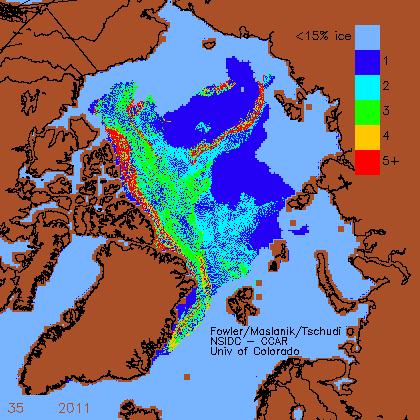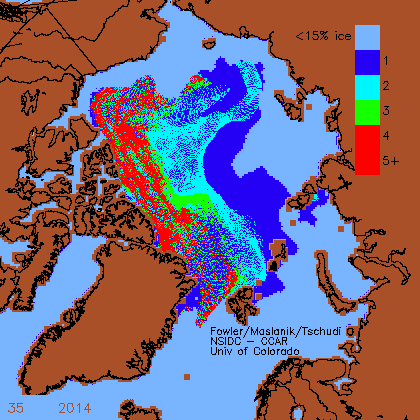The amount of five year old sea ice in the Arctic has increased dramatically over the past three years.
Note that the last date is estimated, assuming that all four year old ice on September 1 becomes five year old ice by the end of September. The actual amount will likely be a little smaller.
End of August 2011
Estimated end of September, 2014. (Map generated by me, based on NSIDC week 35 map.)





The turn??
http://ocean.dmi.dk/arctic/icecover.uk.php
BTW I.ve been wrong about 100% of previous predictions LOL
I hope this ones right LOL
Maybe, perhaps a few more days flat then start to grow,
http://ocean.dmi.dk/arctic/plots/icecover/icecover_current_new.png
NORSEX also showing the ice extent flatting and now above 2009
http://arctic-roos.org/observations/satellite-data/sea-ice/observation_images/ssmi1_ice_ext.png
The Arctic is not a big sea. The growth will not go on forever. But alarmists seem to want it to.
The current weather pattern is in the process of making big ice, just like last winter. The wind is crashing the ice pack against the CArch. to slab and ridge for thick MYI. Nothing is getting exported through the Fram. All of the sea ice area has temp. below freezing to halt melt and snow is falling in the Arch, Laptev and Kara to chill down the water temps for early ice growth. Over half the artic now has temps below -5C which is cold enough to start the new ice growth in any open leads.
My favorite http://earth.nullschool.net/#current/wind/surface/level/overlay=temp/orthographic=-88.06,87.35,1292:
Does that work? Blue is below 0C.
Crashex,
Excellent link. Thanks!
I wonder if NSIDC will unearth a previously unknown model that will have predicted this growth in ice but will still forecast a death spiral which only a climate tax can prevent?
O-buoy 9 near the pole is getting down to almost -20C. That’s pretty cold for this time of year.
http://obuoy.datatransport.org/data/obuoy/var/plots/buoy9/campbell/temperature-1week.png?timestamp=1410367324321
I love this: “The amount of five year old sea ice in the Arctic has increased dramatically over the past three years.” Should it be called “retro ice”?
Or “rotten”.
I never will forget Doc Barber’s trip along the edges one summer a few years ago, and his article using that term. Alarmist idiots parroted that for more than a year. I never hear the term used in that context anymore.
Notice the five-year-old ice northwest of Greenland. Usually that would get sucked sown the east coast of Greenland and melt down by Cape Farewell at Greenland’s southern tip. This year, (don’t ask me why,) the ice has been reluctant to head south, and a lot has actually progressed east to the “wrong” side of Svalbard. All the blue first-year-ice you can see between Svalbard and Franz Josef Land is above-normal-ice-extent for Barents Sea.
Meanwhile, to the west of Svalbard in Fram Strait, and down the east coast of Greenland, you can notice much less ice. This is below-normal-ice-extent for the Greenland Sea.
The ice-extent graph does not differentiate between ice in the Greenland Sea, which you can basically kiss good-bye, and ice heading east in Barents Sea, which has a longer life expectancy.
It is actually a sign of losing ice to have a lot in the Greenland Sea. If you are rooting for an increase in ice, you don’t want to see it all heading south. So far, it is not heading south.
As the winter comes on high pressure often builds over Greenland, with a strong north wind in Fram Strait, so we should expect some of that five-year-ice to eventually get flushed south. However it sure is taking its sweet time about doing so, this year.
All the five-year-ice north of Canada and Alaska has a far longer life expectancy, and will be around next melt season. It must travel clockwise around the Beaufort Gyre all the way to the Laptev Sea before hitching a ride on the Transpolar Drift, to cross the Pole towards Fram Strait. Oddly, it has been putting on the brakes and actually backing up, north of Alaska, for the past few weeks. The reason it looks like ice has been shrinking away from the coast of Alaska is not due to ice melting, but due to ice moving back and to the north.
http://sunriseswansong.wordpress.com/2014/09/03/arctic-sea-ice-melt-the-minimum/
Is the key right for the second graph..in the first one red is 5+, but in the second red is 4 and 5+
That is the point. In two weeks all the 4 year old ice will be five year old ice.
Yeah, we are a week or two away from the change over…my how time flies.
oops sorry..I missed out an important sentence when going through that